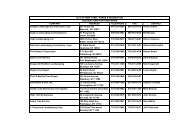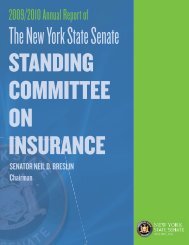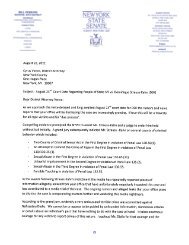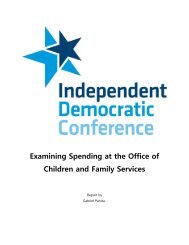Crime Committee Report e.indd - New York State Senate
Crime Committee Report e.indd - New York State Senate
Crime Committee Report e.indd - New York State Senate
You also want an ePaper? Increase the reach of your titles
YUMPU automatically turns print PDFs into web optimized ePapers that Google loves.
In Reynolds v. Sims, 377 U.S. 533 (1964), the Supreme Court held that state legislative districts<br />
must represent a roughly equal number of people. Affirming the “one person, one vote” principle,<br />
Chief Justice Warren minced no words in his celebrated opinion, writing, “Legislators<br />
represent people, not trees or acres. Legislators are elected by voters, not farms or cities or economic<br />
interests. As long as ours is a representative form of government, the right to elect legislators<br />
in a free and unimpaired fashion is a bedrock of our political system.” The Census Bureau’s<br />
current methodology undermines the “one person, one vote” principle supported by prevailing<br />
public values as well as constitutional jurisprudence. The Census Bureau’s current methodology<br />
also violates the <strong>New</strong> <strong>York</strong> <strong>State</strong> law in two ways: it runs afoul of the <strong>New</strong> <strong>York</strong> <strong>State</strong> Constitution<br />
which states in Article 2, section 4 that for the purpose of voting, “no person shall he deemed to<br />
have gained or lost a residence ... while confined in any public prison”; Similarly, subdivision 1 of<br />
section 5-104 of the <strong>New</strong> <strong>York</strong> Election Law directs that “For the purpose of registering and voting<br />
“no person shall be deemed to have gained or lost a residence...while confined in any public<br />
prison. In addition, the 1894 <strong>New</strong> <strong>York</strong> Court of Appeals decision in People v Cady, 37 N.E. 673<br />
(N.Y. 1894), stated that people in prison could not be considered residents of the prison where<br />
they are incarcerated. Based on federal and state law, people in prison therefore remain legal<br />
residents of their address prior to incarceration. Unfortunately, the current Census Bureau’s<br />
methodology disregards this, instead counting a significant proportion of the national population<br />
in the wrong place. Crediting the population of prisoners to the Census block where they<br />
are temporarily and involuntarily held creates electoral inequities at all levels of government.<br />
These electoral inequities are apparent in <strong>New</strong> <strong>York</strong> <strong>State</strong>, where with a prison population of<br />
approximately 60,000, over 75% of people in prison are people of color and over 70% are from<br />
urban communities. Thus, urban communities such as Albany, Buffalo, <strong>New</strong> <strong>York</strong> City, Rochester,<br />
and Syracuse are being counted for the purposes of redistricting in rural communities,<br />
leading to vote dilution for urban communities of color across the state. The most significant<br />
vote dilution, however, in rural communities as most counties, cities, and towns use federal<br />
census data to draw their local legislative district and ward boundaries. St. Lawrence County,<br />
in northern <strong>New</strong> <strong>York</strong>, drew legislative districts with Census 2000 data that included more than<br />
3,000 people in three correctional facilities as if they were actual residents of two small towns,<br />
Ogdensburg and Gouverneur. The increased voting power of Ogdensburg and Gouverneur<br />
residents diluted the votes in the many St. Lawrence County residents who do not live near<br />
those prisons. This inequity created a long-running and disruptive controversy in St. Lawrence,<br />
and a petition opposing the unequal representation gathered more than 2,000 signatures.<br />
County legislators and supervisors in 13 counties in <strong>New</strong> <strong>York</strong> <strong>State</strong> hav subtracted the prison<br />
population from the official count prior to drawing county legislative districts or designing weighted<br />
voting systems to ensure equal representation and avoid creating a legislative districts that have<br />
more people in prison than actual residents. The counties that have corrected the census data to<br />
remove people in prison before redistricting include: Cayuga, Chemung, Clinton, Dutchess, Essex,<br />
Franklin, Greene, Orange, Orleans, Schoharie, Sullivan, Washington, and Wyoming.<br />
Standing <strong>Committee</strong> on <strong>Crime</strong> Victims, <strong>Crime</strong> and Correction | 2009-2010 <strong>Report</strong> 51



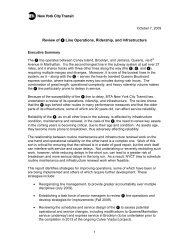


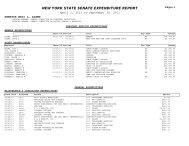
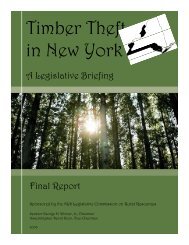

![[PDF] Proposed MTA Capital Program - New York State Senate](https://img.yumpu.com/24854139/1/190x245/pdf-proposed-mta-capital-program-new-york-state-senate.jpg?quality=85)

